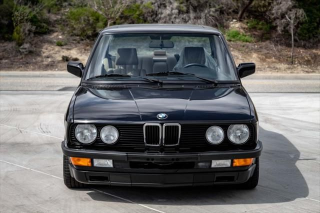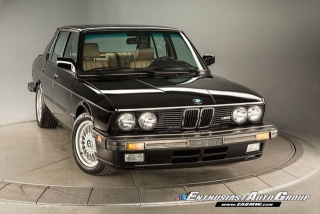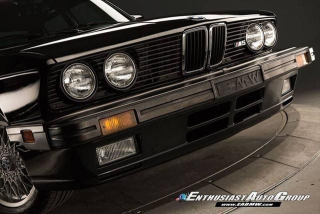The 1988 BMW 5-Series, part of the E34 generation (1987-1996), is a mid-size luxury sedan renowned for its executive-class appeal and driving dynamics. Available as a sedan and later a wagon, key trims included the 525i and the more powerful 535i. Its popularity stemmed from blending sophisticated design with engaging performance, making it a benchmark for sport sedans.
The Good
The 1988 5-Series offers a compelling blend of exhilarating performance, robust reliability, and refined comfort. Its timeless design appeals to emotional buyers, while its practical value and efficient engineering satisfy the pragmatic.
The Bad
Potential weaknesses for the 1988 BMW 5-Series include aging electrical systems, particularly wiring harnesses and sensor failures. Coolant leaks, head gasket issues, and worn suspension components are also common concerns requiring attention.
1988 BMW 5-Series: Quick Overview
- Engine Options:
- 2.5L Inline-6 (M20B25): Naturally aspirated, producing approximately 168 horsepower.
- 3.5L Inline-6 (M30B35): Naturally aspirated, producing approximately 208 horsepower.
- Horsepower: Ranging from 168 hp for the 525i to 208 hp for the 535i.
- Fuel Economy: Estimated at around 17-19 MPG city and 22-25 MPG highway, depending on engine and transmission.
- 0-60 Times: Approximately 8.5-9.5 seconds for the 525i and 7.0-7.5 seconds for the 535i.
- Towing Capacity: Not typically rated or designed for towing.
- Trim-Level Features:
- 525i: Standard features often included power windows, locks, mirrors, a sunroof, and a premium sound system. Optional features could include leather upholstery, automatic climate control, and limited-slip differential.
- 535i: Typically included all 525i features plus a more powerful engine, sport suspension (optional), upgraded interior materials, and potentially a more advanced onboard computer. Optional features could include heated seats and cruise control.
- M5 (S38B36): While the M5 was technically a 1988 model in some markets, it represented the pinnacle with a 3.6L inline-6 producing 310 hp, 0-60 in under 6 seconds, and a sport-tuned chassis, brakes, and aerodynamic enhancements.
1988 BMW 5-Series Specifications
Vehicle Information
| Year | 1988 |
| Make | BMW |
| Model | 5-Series |
| Trim | - |
| Style | - |
| Type | Sedan |
| Category | Compact Car |
Manufacturing Details
| Made In | Germany |
| Manufacturing City | MUNICH OR DINGOLFING |
Dimensions
| Doors | 4-Door |
| Curb Weight | - |
| Gross Vehicle Weight Rating | - |
| Overall Height | 55.70 inches |
| Overall Length | 189.00 inches |
| Overall Width | 66.90 inches |
| Wheelbase Length | 103.30 inches |
| Standard Seating | 5 |
Engine & Performance
| Engine | 3.4-L L-6 SOHC 12V |
| Engine Size | 3.4L |
| Engine Cylinders | 6 |
| Transmission | 4-Speed Automatic |
| Transmission Type | Automatic |
| Transmission Speeds | 4-Speed |
| Drivetrain | Rear-Wheel Drive |
Additional Features
| Anti-Brake System | 4-Wheel ABS |
| Steering Type | Recirculating |
Pricing
| Manufacturer Suggested Retail Price (MSRP) | $36,700 |
| Invoice Price | - |
| Delivery Charges | - |
Vehicle History Report
Vehicle
Specifications
Specifications
Ownership
History
History
All History
Events
Events
NMVTIS Title
History Check
History Check
Salvage/Rebuilt
Check
Check
Accident
Check
Check
Theft
Check
Check
Open Lien
Check
Check
Past Sale
Listings
Listings
Safety
Recalls
Recalls
Odometer
Check
Check
Market Price
Analysis
Analysis
What Problems Does the 1988 BMW 5-Series Have?
The 1988 BMW 5-Series, while generally well-built, is susceptible to age-related issues. Frequently reported problems include failing heater control valves, which can lead to inconsistent cabin temperatures or leaks. The wiring harnesses, especially around the engine bay and dashboard, can degrade over time, causing intermittent electrical gremlins such as malfunctioning gauges, lights, or power accessories. The Motronic engine control unit and its associated sensors are also prone to failure, impacting engine performance and drivability. Oil leaks from the valve cover gasket, oil pan, and front/rear main seals are common due to aging rubber seals. The cooling system is another area of concern; radiator leaks, failing water pumps, and cracked expansion tanks can lead to overheating. On manual transmission models, clutch wear is expected, and on automatic transmissions, issues with the torque converter or transmission control module can arise. Suspension components like bushings, ball joints, and tie rods will likely need replacement on higher-mileage examples, leading to clunks or imprecise handling. Specifically for 1988, while there weren't widespread major recalls affecting the entire model year, individual components could experience failures. Long-term reliability hinges heavily on consistent maintenance and prompt attention to minor issues before they escalate. For instance, neglecting coolant leaks can lead to catastrophic engine damage, and ignoring electrical faults can become progressively more complex and expensive to diagnose.
How long will the 1988 BMW 5-Series last?
With diligent maintenance, a 1988 BMW 5-Series can reasonably achieve 200,000 to 300,000 miles or more. Owner data suggests that vehicles receiving regular oil changes, timely coolant flushes, and prompt attention to suspension wear can remain reliable workhorses for decades. The inherent strength of BMW's inline-six engines contributes significantly to their long-term durability. However, weaknesses that emerge over time include the aforementioned electrical issues and the general wear and tear on rubber and plastic components common to vehicles of this vintage. The transmission and differential are generally robust, but fluid changes are critical for longevity.
What Technology & Safety Features are Included?
The 1988 BMW 5-Series, while not boasting the sophisticated electronics of modern cars, offered a respectable suite of features for its era. Standard tech included power windows, power locks, power mirrors, and a tilt/telescoping steering wheel. Entertainment was typically handled by a quality AM/FM stereo with a cassette player, often with multiple speakers providing clear audio. Optional features enhanced the luxury and convenience, such as automatic climate control for precise cabin temperature management, cruise control, heated front seats, and a limited-slip differential for improved traction. Driver-assistance features were rudimentary by today's standards, primarily focused on mechanical feedback through the steering and braking systems. Safety features included anti-lock brakes (ABS), which were becoming more common, and front seatbelts. Side-impact protection was also integrated into the door structure. While official crash-test ratings for this specific model year from agencies like the NHTSA are not readily available in modern databases, the E34 chassis was engineered with a strong unibody construction, crumple zones, and a driver-side airbag becoming an option later in the model's life, though less common on early 1988 models. The focus was on a robust, driver-oriented package that prioritized mechanical safety and driver control over electronic aids.
What Colors Options are Available?
1988 BMW 5-Series Prices and Market Value
When new, the 1988 BMW 5-Series was a premium offering. The 525i typically retailed in the range of $30,000 to $35,000, while the more potent 535i could cost upwards of $40,000. The M5, a rare performance variant, commanded significantly higher prices. These vehicles experienced substantial depreciation in their early years, as is typical for luxury cars. However, in the current used market, prices vary widely based on condition, mileage, and maintenance history. Well-maintained examples, especially rarer trims or those with lower mileage, can fetch anywhere from $3,000 to $10,000 or more, with pristine M5 models commanding considerably higher figures. Factors affecting resale value include originality, the presence of service records, and the absence of major rust or deferred maintenance.
1988 BMW 5-Series Cost of Ownership
Owning a 1988 BMW 5-Series can be moderately costly, especially for those unfamiliar with European car maintenance. Insurance rates are typically reasonable for a classic car, but repair costs can be higher than for mainstream vehicles due to parts availability and labor rates. Fuel economy is decent for its class and age, but premium fuel is recommended. Maintenance requires diligence; regular servicing is key. Long-term ownership costs are heavily influenced by the vehicle's condition upon purchase and the frequency of specialized repairs needed due to its age. It's not an economical daily driver if reliability is paramount without investment.
1988 BMW 5-Series Fuel Efficiency
Fuel Type
Gasoline
Fuel Capacity
16.60 gallons
City Mileage
15 miles/gallon
Highway Mileage
21 miles/gallon
1988 BMW 5-Series Warranty
Basic
Original warranty
0 months / No data
Estimated remaining
Expired
Powertrain
Original warranty
0 months / No data
Estimated remaining
Expired
Rust
Original warranty
0 months / No data
Estimated remaining
Expired
1988 BMW 5-Series Insurance
Insurance for a 1988 BMW 5-Series is moderately priced, reflecting its status as a Sedan with strong safety ratings and
reasonable repair costs.
reasonable repair costs.
How Does the 1988 BMW 5-Series Compare to Other Sedan?
In 1988, the BMW 5-Series (E34) competed fiercely with other executive sedans like the Mercedes-Benz W124 E-Class, Audi 100/200, and Lexus LS 400 (which debuted a couple of years later but set a new standard). In terms of performance, the 535i often edged out its rivals with its spirited inline-six engine and engaging handling, offering a sportier driving experience than the more comfort-oriented Mercedes. The Audi 200 offered potent turbocharged performance, while the forthcoming LS 400 aimed for smooth, powerful acceleration and refinement. Features-wise, the 5-Series was well-equipped with luxury amenities, comparable to the Mercedes and Audi, though the LS 400 would soon set a new benchmark for interior technology and quietness. Reliability is a mixed bag; BMWs of this era are known for their robust powertrains but can be plagued by electrical gremlins and aging rubber components, often requiring more attention than a well-maintained Mercedes or a newer Lexus. Price-wise, the 5-Series was positioned as a premium German option, often slightly more performance-oriented and potentially less expensive than a comparable Mercedes-Benz. Similar alternatives could include a well-preserved Mercedes-Benz W124, known for its exceptional build quality and durability, or an Audi 200 for turbocharged power. For those prioritizing outright reliability and luxury refinement over sporty driving dynamics, an early Lexus LS 400, despite being a slightly later model year, would be a compelling alternative, though its used market prices might be higher.
Final Verdict: Is the 1988 BMW 5-Series a Good Sedan?
The 1988 BMW 5-Series is ideal for enthusiasts who appreciate classic German engineering, engaging driving dynamics, and timeless design, and who are willing to perform or oversee necessary maintenance. It is worth buying for those seeking a rewarding driving experience and a stylish sedan, particularly in well-maintained condition. Buying used is the only option, and focusing on lower-mileage examples with documented service history is crucial. The 535i offers a better balance of performance and comfort for general use, while the 525i is a more accessible entry point. Avoid cars with significant rust or complex electrical issues unless you are prepared for substantial investment.


